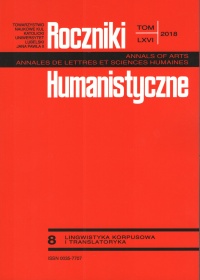In Search of Interlingual Equivalence within the Source Domain of “Temperature” in Polish and Italian Language Metaphors
Abstract
The aim of this article is to carry out a comparative analysis of two adjective series referring to intermediate temperature states in Polish and Italian. The subject of the study is a metaphorical use of the following adjectives in the area of broadly understood emotion: caldo – caloroso –tiepido – freddo for Italian and gorący – ciepły – letni – chłodny – zimny for Polish. The comparative material within the indicated carriers of metaphors is the Italian-language and Polish-language dictionaries available on-line, along with the Sketch Engine Corpus.
References
Arystoteles, 2004, Retoryka; Retoryka dla Aleksandra; Poetyka, przeł. Henryk Podbielski, Warszawa, Wydawnictwo Naukowe PWN.
Black Max, 1983, Modelli, archetipi, metafore, Parma, Pratiche.
Black Max, 1993, «More about metaphor» [in:] Metaphor and thought, ed. A. Ortony, Cambridge, Cambridge University Press, 19-41.
Fauconnier Gilles, Turner Mark, 2001, Amalgami: introduzione ai network di integrazione concettuale, Urbino, Quattro venti.
Fauconnier Gilles, Turner Mark, 2002, The way we think: conceptual blending and the mind’s hidden complexities, New York, Basic Books.
Kövecses Zoltán, 2010, Metaphor. A Pratical Introduction, 2nd edition, Oxford, Oxford University Press.
Lakoff George, Johnson Mark, 1988, Metafory w naszym życiu, Warszawa, Państwowy Instytut Wydawniczy.
Pajdzińska Anna, 2000, «„Temperatura” jako domena źródłowa metafor językowych» [in:] Annales Universitatis Mariae Curie-Skłodowska, Sectio FF, vol. XVIII, 201-212.
Quintiliano Marco Fabio. L’istituzione oratoria, vol. 2, Torino, UTET (edizione del 1979 a c. di R. Faranda, P. Pecchiura).
Richards Ivor Armstrong, 1967, La filosofia della retorica, Milano, Feltrinelli.
Copyright (c) 2018 Roczniki Humanistyczne

This work is licensed under a Creative Commons Attribution-NonCommercial-NoDerivatives 4.0 International License.





